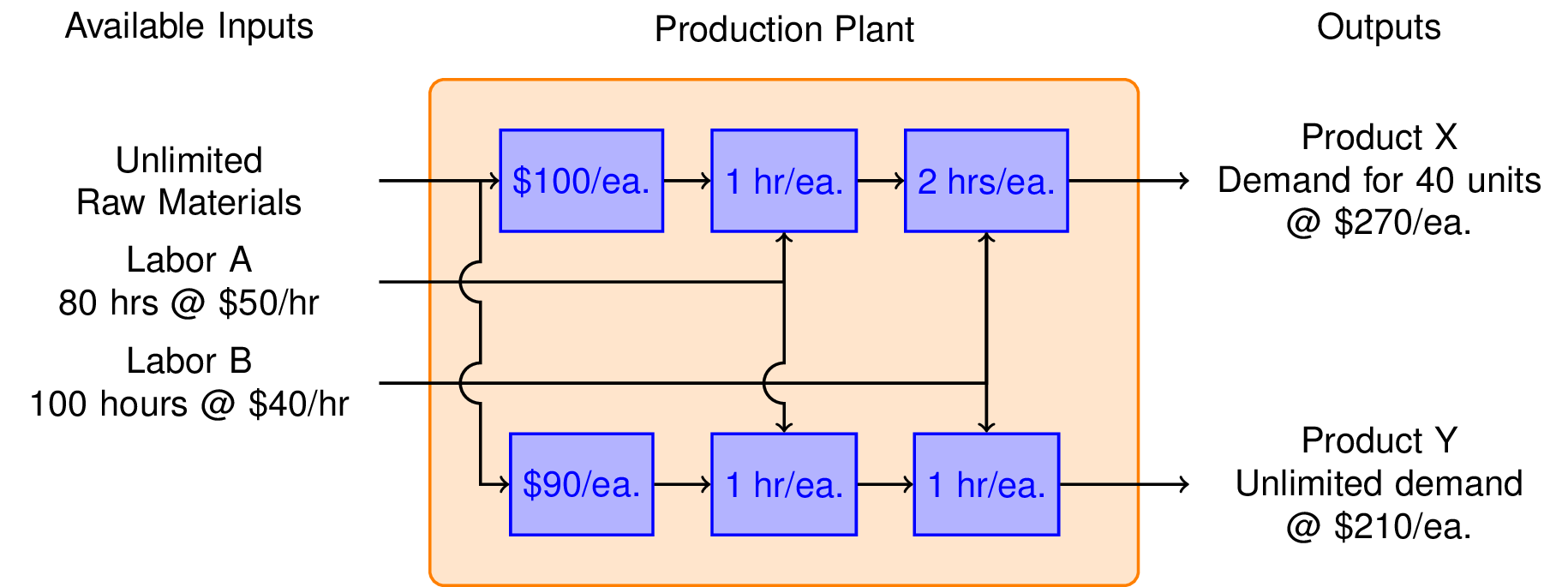Style Sampler
Layout Style
Search News Posts
Production Plants and Processes
Suppose you are thinking about starting up a business to produce Product X. You have determined there is a market for X of up to 40 units per week at a price of $270 each. The production of each unit requires $100 of raw materials, 1 hour of type A labor, and 2 hours of type B labor. You have an unlimited amount of raw material available to you, but only 80 hours per week of labor A at a cost of $50/hour, and 100 hours per week of labor B at a cost of $40 per hour. Ignoring all other expenses, what is the maximum weekly profit?
To get started on this problem, we sketch a flow diagram illustrating the flow of raw materials and labor through the production plant.
This study demonstrates the use of linear programming to maximize profit for a simple model of a multiproduct production facility. We used Pyomo to represent the model with the glpk solver to calculate solutions.

The essential decision we need to make is how many units or Product X to produce each week. That's our decision variable which we denote as x. The weekly revenues are then $270x. The costs include the value of the raw materials and each form of labor. If we produce x units a week, then the total cost is $40x. which means there is a profit earned on each unit of X produced, so let's produce as many as possible.
There are three constraints that limit how many units can be produced. There is market demand for no more than 40 units per week. Producing x = 40 units per week will require 40 hours per week of Labor A, and 80 hours per week of Labor B. Checking those constraints we see that we have enough labor of each type, so the maximum profit will be $1600 per week. What we conclude is that market demand is the 'most constraining constraint.' Once we've made that deduction, the rest is a straightforward problem that can be solved by inspection.
Your marketing department has developed plans for a new product called Y. The product sells at a price of $210 each, and they expect that you can sell all that you can make. It's also cheaper to make, requiring only \$90 in raw materials, 1 hour of Labor type A at $50 per hour, and 1 hour of Labor B at \$40 per hour. What is the potential weekly profit?

After our data calculation We see the profit per unit of Y is smaller. So a decision to produce Y instead of X must be based on the ability to make Y in larger quantities. Compared to product X, we can manufacture and sell up 80 units per week for a total profit of $2,400.
So far we have learned that we can make $1,600 per week by manufacturing product X, and \$2,400 per week manufacturing product Y. Is it possible to do even better?
To answer this question, we consider the possibilty of manufacturing both products in the same plant. The marketing department assures us that product Y will not affect the sales of product X. So the same constraints hold as before, but now we have two decision variables, x and y. .

The optimal solution is found at the intersection of constraints corresponding to Labor A and Labor B. These are the active constraints. Adding additional labor of either type will increase the profit. By contrast, the demand constraint for product X is inactive at the optimum, therefore attempting to increase demand for product X would be wasted effort.
This leaves the important question of how much the profit will increase if additional resources are available. Let's see what happens if one additional hour of Labor A is available.
Optimization terminated successfully.
x = [ 19. 62.]
objective = -2620.0
An additional hour of Labor A increases the profit by $20. The base cost of $50/hour for Labor A is included in the objective function. Therefore we should be willing to pay up to $50 + $20 = $70/hour for additional Labor A.
With our Image Analysis service, you can apply different filters to images and obtain a histogram map. The demoplatform image service provides a comprehensive set of reference standard algorithms and workflow applications for analysis, visualization, and algorithm development. You can perform image segmentation, image enhancement, noise reduction, geometric transformations and image recording using deep learning and traditional image processing techniques. Toolbox supports processing of 2D, 3D and arbitrarily large images.
Analysis Result: